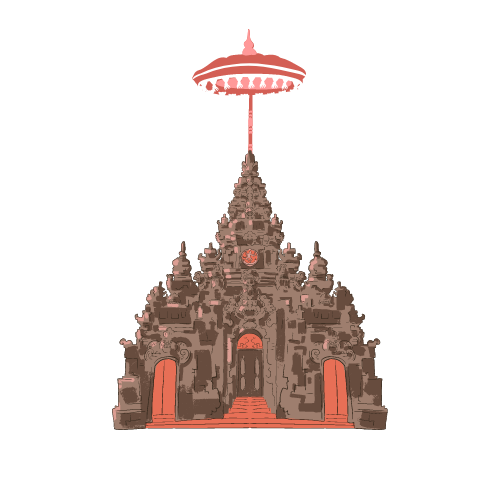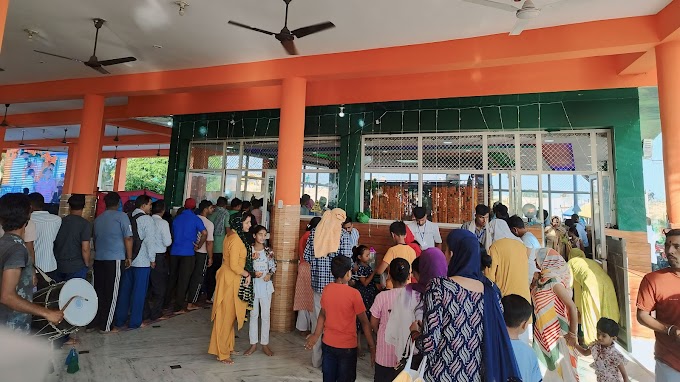The journey of the construction of this temple covers the struggles of so many years and the sacrifices of numerous people. Yes, I am talking about - Shri Ram Temple Ayodhya. Ayodhya Ram Mandir, also known as Shri Ram Janambhoomi, is a Hindu temple located in Ayodhya, Uttar Pradesh, India. Ram Mandir Pran-Pratishtha was performed on January 24, 2024, and Prime Minister Shri Narendra Modi inaugurated it. In this article, we will read about the history of this temple and will know the ways by which one can reach Ayodhya Ram Mandir.
Shri Ram Temple Ayodhya:
Ayodhya is known as Shri Ram Janambhoomi because Shri Ram Ji took birth here. This place is considered a Holy site. According to the Ramayana, the location of Shri Ram Ji's birth is on the bank of the Sarayu River in "Ayodhya" city which is now present in the North Indian State of Uttar Pradesh. Most Hindus claim that the exact site of Bhagwan Ram Ji's birthplace is within the ground where Babri Masjid once stood. The Journey of Shri Ram Temple Ayodhya and Babri Masjid dispute and the formation of New Ram Mandir Ayodhya is very long. Let's know about this journey in brief.
Ayodhya Ram Mandir History:
Shri Ram Janambhoomi is considered to be one of the most important pilgrimage sites for Hindus. Ram Lalla Temple is a religious center for people. People used to worship there. The whole story of Shri Ram Temple Ayodhya and Babri Masjid started centuries ago.
In 1528, Ram Lalla Mandir demolished and constructed a Masjid-i-Janmasthan(later known as Babri Masjid) mosque on the site of Shri Ram Janambhoomi by the commander of Mughal Empire, Mir Baqi, under the order of Babur. Then in 1853, for the first time, a group of Hindus belonging to the "Nirmohi Akhara" with arms occupied the Babri Masjid site and claimed their ownership of the site. Civil administration had to step in and in 1855, the premises of the mosque divided into two parts: one for Hindus and another one for Muslims.
In December 1858, Hindus were prohibited from conducting pooja at the site by the British Administration. They created a platform for conducting pooja and rituals outside the mosque. In 1883, Hindus tried to construct a temple over the platform. The administration jumped into this matter and denied Hindus to construct a mandir over the platform. Then the Hindus took this matter into court but dismissed the lawsuit by the Sub Judge Pandit Hari Kishan Singh in 1885 and later also dismissed by the higher courts in 1886. The basis of this dismissal is that the formation of a Hindu temple close to the mosque would create a serious law and order issue.
Also Read My Recent Post : Mata Vaishno Devi Mandir | Katra, Jammu | Temple History
After this, In December 1949, some idols of Ram Ji and Sita Ji were placed by some people in the premises and claimed that they appeared there miraculously. By 1950, the state took full control of the structure and allowed only Hindus to perform their rituals and prayers at this site under the section of 145CrPC.
All the political parties and groups including the Vishva Hindu Parishad started a campaign. The main motive of the campaign was to construct a temple where Bhagwan Ram was born. Rajiv Gandhi's government allowed Hindus to access the site for prayers and rituals in 1985. All the government authorities gave Vishva Hindu Parishad permission for Shilanyas. It was decided that Shilsnyas would be outside the disputed site. But on 9th November 1989, Shilanyas was done adjacent to the disputed site by a group of Vishva Hindu Parishad and Sadhus.
On 6 December 1992, a rally was organized by VHP and BJP(Bhartiya Janta Party) which involved around 1,50,000 karsevaks. The rally turned violent and out of control of security forces. In no time, the crowd demolished the mosque. This demolition resulted in inter-communal riots between Hindu and Muslim Communities leading to over 2,000 deaths in Mumbai and around 30 temples were attacked set on fire and demolished in Pakistan and Bangladesh.
Must Read : How Sankat Mochan Hanuman Mandir was Built | Know the story Behind
In 2003, the Court ordered for Archaeological Survey. The Archaeological Survey Of India(ASI) excavated the site. The report of ASI indicated the presence of a 10th-century north Indian-style temple found under the mosque. The opposition group named it "Politics" and denied it. The report submitted by ASI was used as strong evidence by the Allahabad High Court that the structure on the site was a massive Hindu religious building. On 5th July 2005, five terrorists attacked Shree Ram Temple in Ayodhya. Central Reserve Police Force(CRPF) shot them dead in the encounter. India faced one civilian casualty and three CRPF casualties, out of three, two were badly injured with multiple gunshot wounds. In the 2009 election, the Bhartiya Janta Party(BJP) promised to construct a Ram Lalla Mandir at the site and also include this in its election manifesto. In 2010, the Allahabad High Court decided to split the disputed land into 3 equal parts. One part is for the construction of Ram Lalla Mandir, the other one for Muslims, and the last one for the Hindu religious denomination Nirmohi Akhara. People were not satisfied by this division decision and they appealed against it to the Supreme Court.
In 2019, a bench of five Supreme Court Judges heard the dispute cases. By considering all the evidence provided Supreme Court concluded that There is a time gap between the existence of the pre-existing structure in the 12th century and the construction of the mosque in the 16th century, with no archaeological evidence available on the cause of the destruction of the underlying structure from this period.
On 9 November 2019, the Supreme Court ordered the land to be handed over to build a Hindu temple and also ordered the government to give 5 acres of land to the Sunni Waqf Board to build the mosque. Shri Ram Janmabhoomi Teerth Kshetra trust was formed by the government of India on 5 February 2020. Then the trust began the first phase of construction of Shri Ram Temple Ayodhya in March 2020.
Bhoomi Poojan of mandir was performed by Prime Minister Shri Narendra Modi in Ayodhya on 5 August 2020. Fund Raising campaign was started to construct the Shri Ram Mandir Ayodhya on 14 January 2021. President of India Ramnath Kovind was the first person to contribute by donating 5,00,000 rupees for the construction of Ram Lalla Temple. Approximately 50 billion rupees were received by the temple trust.
On 22 January 2024, the idol of Ram Lalla was installed in the garbhagriha. This is how the Shri Ram Temple Ayodhya is built.
Attraction of Temple:
Shri Ram Lalla Temple itself is a center of attraction without any doubt. Millions of devotees from across the world are now coming to see Ram Lalla Mandir in Ayodhya. It gives a memorable experience of serene prayer, meditation, and connection to Indian culture and history. Apart from this, there are many other temples one must visit in their Ayodhya Journey.
- Hanuman Garhi
- Mani Parbat
- Kanak Bhavan
- Sita Ki Rasoi
- Dasrath Bhavan
- Nageshwarnath Temple
- Treta Ke Thakur
- Bharat Kund
- Ramkot
- Suryakund
- Makhbhoomi
- Guptarghat
More Details:
Shri Ram Mandir Location: Q5WV+6V, Ayodhya, Uttar Pradesh, 224123
Shri Ram Mandir Official Website: Click Here
Ram Mandir Ayodhya Darshan Timings: Morning:- 6:30 am to 12 pm
Evening:- 2:30 pm to 10:00 pm
Ram Mandir Ayodhya Aarti Timings:
- Mangala Aarti- 4.30 am
- Shringaar Aarti- 6.30 to 7.00 am
- Bhog Aarti- 11.30 am
- Midday Aarti – 2.30 pm
- Evening Aarti- 6.30 pm
- Shayan Aarti- 8.30 to 9.00 pm
How To Reach Ram Mandir Ayodhya:
By Air: Maharishi Valmiki International Airport is the nearest airport to Ram Mandir Ayodhya. Once you reach the airport, book a taxi for a short ride.
By Bus: Once one reaches Lucknow, one can book a private vehicle and taxi to Ayodhya. It will take around 2-3 hours depending on the traffic conditions.
By Train: Ayodhya Railway Station is the nearest railway station. One can book a ride from the station to New Ram Mandir Ayodhya.
Frequently Asked Questions:
Ques 1- How many acres are in Ayodhya Ram Mandir?
Ans 1- Total area of 2.7 acres in which Shri Ram Mandir Ayodhya is built.
Ques 2- Where is Ram Mandir Ayodhya located?
Ans 2- Ram Mandir Ayodhya is located in Ayodhya city of Uttar Pradesh. Location is: Q5WV+6V, Ayodhya, Uttar Pradesh, 224123.
Ques 3- When was the construction of the Ram Mandir in Ayodhya completed?
Ans 3- Construction of Shri Ram Mandir Ayodhya is expected to be finished in December 2024.
Ques 4- Why is there no Sita in Ram Mandir, Ayodhya?
Ans 4- The Idol of Ram Lalla installed in Shri Ram Mandir Ayodhya is in the form of a 5-year-old child. Sita Mata had not entered Ram Ji's life at that age, that's why there is no idol of Mata Sita.
Ques 5- Why is Ram Mandir Murti black?
Ans 5- Ram Lalla's Murti is made using a special kind of rock known as "Shaligram". Shaligram has great importance in the Hindu religion. It is a representation of Bhagwan Vishnu.
Thank you for reading. Join us to delve deeper into India's sacred sites.











